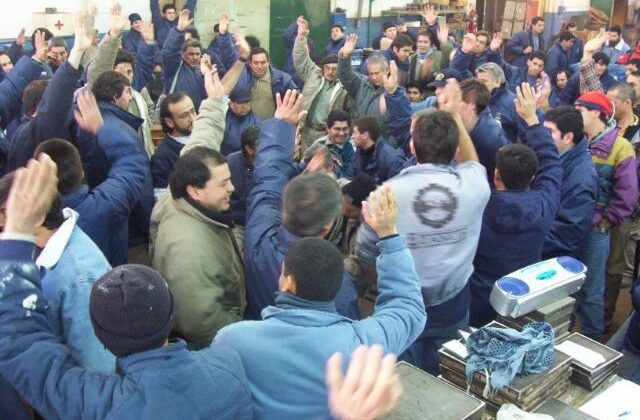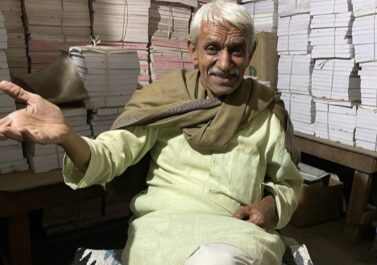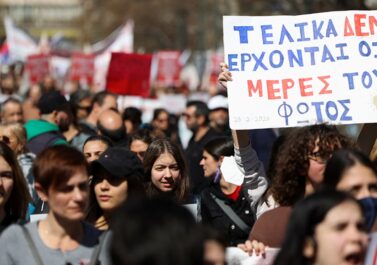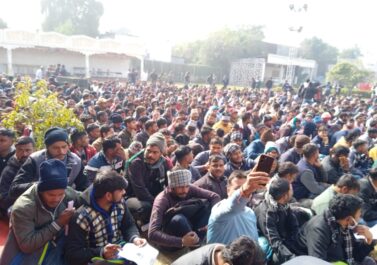We interviewed a comrade from Germany who has been following events and movements in South America. She works as a postal worker for DHL. The initial introduction to the series can be found here: https://letsgetrooted.wordpress.com/2020/09/05/working-class-internationalism-series/
“I went to South America for the first time in 1981, to Columbia. My Spanish wasn’t that good back then and we didn’t have many contacts. It was also pretty dangerous at the time. It wasn’t easy to deal with the level of poverty as a ‘visitor’. Two years later I visited Cuba, which was a different experience in social terms, but then I stopped going to South America for ten years. I thought that it made little sense to ‘just visit’, as a kind of political tourism. What’s the point in seeing the situation without getting actively involved?
Things changed at the beginning of the 1990s when a friend, who was in political exile in Germany, returned to Uruguay after the end of the dictatorship. Another friend decided to go and visit her and see what happens when a guerrilla, the Tupamaros, tries to establish itself as a legal movement. My friend also realised that there was a very interesting and active workers’ movement in Uruguay. He then started a solidarity association, initially for the Tupamaros’ grassroots radio, but we then expanded this solidarity initiative to all the rank-and-file alternative radio initiatives (‘radios comunitarias’) that emerged. At the time printing and buying newspapers was expensive, so radios were crucial for informing and mobilising people. These radio stations then invited us over, this is the first time I went to Latin America again.
We started to invite militants from South America to Germany, because we thought this one-way street of comrades from richer countries going south was strange. We organised three exchanges with comrades from Bolivia, Argentina and Uruguay, mainly with trade union militants and people from the working class radio stations. This was all self-organised, but we received funding from various charitable institutions. At the end of the 1990s, we tried to organise a solidarity action with workers in a leather factory in Uruguay that was owned by a German corporation. Conditions were bad, they used chemicals that made people sick. The problem was that the small factory in Germany was in a small village. We nevertheless started a campaign. We picketed the main outlet together with comrades from the Clean Clothes Campaign and the FAU. We didn’t manage to create direct links between workers, but the protest did manage to change things in the factory in Montevideo.
In 2001, an uprising erupted in Argentina. Comrades encouraged me to go see what was happening. I went for four weeks in April 2002. I went on my own, which was a good experience, because you then make more of an effort to actually meet local people. In the following years I visited comrades in Argentina every year. My last trip was to Chile, during the uprising in 2019.
During the 2001 uprising in Argentina it helped to know the people from the movement radio stations. Some of them had just started to build a network of correspondents. Many people walked through the city in revolt and recorded what people on demonstrations or in assemblies had to say. They also had a small recording van, which they used to visit various places where uprisings were happening. I was able to travel with them, which was great.
During the uprising it was very easy to talk to anyone in the street. People wanted to discuss. My contact to the occupied companies wasn’t established through the radios, I just stumbled over a poster announcing an assembly of occupied factories. This took place on a blocked six-lane highway, where they placed hundreds of chairs for people to gather. That was very inspiring, so I decided to visit some of these factories during my next visit. The first one was the Brukman garment factory, also because they were women. My idea was that I would just work with them for a few weeks in the factory, that’s the best way to learn about a situation. I asked them through the grassroots radio, but they said that the situation was difficult and that instead I should work at Zanon, an occupied ceramic tile factory. I was a bit sceptical, because it was far away in Patagonia and nearly only male colleagues were working there.
When I arrived there they said that I can sleep in the factory and talk to people. I realised it was very different from rocking up for a day and interviewing people. You get a better picture if you stay with people for weeks, see how they work, talk about all kinds of things. That was a good experience. I was able to write a longer report that we distributed in Europe. [1] The other thing that came out of this visit was a visit of two workers to Germany – one from Zanon, one from Brukman. We organised this through an internationalist left-wing trade union organisation called TIE. [2] We travelled through Germany for three weeks, organised events, visited shop-stewards at Alstom turbine plant, who were threatened with factory closure. The comrades from Argentina also wanted to see how things work in Germany. The Alstom workers were very interested, but in terms of a workers’ takeover, a tile factory is very different from a more complex turbine manufacturing plant. We also visited a factory in Cologne and the comrades from Argentina were surprised about the luxurious works council office, the official representative of the employees. The Zanon worker said that even with a good translation they would never be able to understand each other.
In October 2019, people in Chile kicked off. I had the chance to be there for eight days. I met great people, took part in assemblies. Through an exiled comrade in Germany we established contacts to activists who organised assemblies in the poorer areas of Santiago. We got to know some of the younger folks and joined them during the town centre protests. All the people we talked to said that the increase of the metro fares was only a trigger, but that people were fed up with the entire system. Not only neoliberalism. They started questioning the entire way of life. People stopped pretending to their neighbours, but started to talk openly about their problems. So far there have not been any major company occupations, but people come together in solidarity. The first time I came to the main square, I had the feeling that something major was happening, but it was difficult to express it in words; a feeling of a new openness and togetherness amongst people.
Once the pandemic and the lockdown kicked in, the slogan emerged: ‘only the people care for the people’. It was clear that those in power would not give a shit about the people in the poorer areas. No medical aid, no food provisions, nothing. In reaction to this, people organised food-banks and mutual aid everywhere. People said that the new relationships created during the uprising later on became the basis for the solidarity during the pandemic and also for the campaign for the referendum for a new constitution. Despite strict curfews, the political organising process continued.
The demand for constitutional reform became a common focal point. The constitution stems from the time of the dictatorship and inscribes the absolute privilege of private property. This in turn means that many legal changes become impossible. At the same time, many people said that the political class only pushed the referendum on the constitutional reform in order to get us off the streets. This is why, initially, many groups said they would not take part in it. But this changed, and in the end many people said that if we lose the referendum it will be very difficult to maintain the dynamic of the uprising in October 2019. The fact that the referendum was won with a big majority of 80% also shows that the mobilisation in the poorer areas continued. At the same time, many people on the left discuss the fact that none of the so-called ‘21st century socialism’ governments managed to break out of extraction economy. They financed basic welfare for the poor by an increased dependence on raw material extraction and world market prices.
People took part in the uprising primarily as impoverished workers, not as as a collective workforce of particular companies. The dockers went on strike and the copper miners were forced to go on strike. The impoverished people blockaded the access roads to the mines. There was criticism: “You miners have got the power, but you only use it in your own interest”. Many people work in informal jobs. Young activists from the poorer areas left their jobs during the uprising. When it comes to my own wage work, it unfortunately does not connect directly to what I am doing in South America. In 2017 I met DHL workers in Chile, which was very interesting, because we could see that management acts similarly, whether you are in Germany or Chile. It was a good meeting, but with no immediate results. On a personal level, my experiences of working in factories and warehouses were indispensable. It was easier to grasp and relate to the situation at Zanon because of having worked in similar places myself.
The parallel between Argentina 2001 and Chile 2019 is the widespread urge for grassroots structures where everyone can participate, and the level of mistrust in leaders. In Argentina this expressed itself in the assemblies, but due to the deep roots of Peronism, which is a strange mixture of leadership cult and welfare policies, these rank-and-file structures became re-integrated fairly quickly. People wrote a lot about the horizontal structures of the piqueteros, the unemployed movement, and these structures existed – but a majority of these groups were in some form attached to political parties or Peronist organisations. It was relatively easy to re-integrate them. This might be different in Chile, but we will have to see. The icon of the movement in Chile was a dog, the ‘negro matapacos’ (black cop killer).
Subcultures are significant when it comes to the question how these movements can overcome national borders. In Uruguay in the 1990s, I experienced that those kids who went to punk gigs knew much more about what was happening in neighbouring Argentina than our political comrades. These kids travel whenever possible and create their own networks. Music and subculture also played a big role in the recent uprising in Chile. There are soundtracks of the global revolt that travel through countries, through football stadiums, to re-emerge on the protest marches and occupations. There was a recent wave of land occupations in Argentina, after many people lost their homes. In October 2020, kids in Buenos Aires tried to defend the occupation, using similar militant tactics like those developed by the ‘primera linea’ in Chile a year earlier.
Migration within the region also plays a role. In Argentina, there are many people from Bolivia and Paraguay, many of them working in illegal garment sweatshops. Racism against these migrants from the Andes was widespread. I think the uprising helped to make the struggle of these workers more visible and to undermine racism. In Chile there are many migrant workers from Haiti and there is racism towards the Mapuche. The recent revolt has questioned these divisions. A lot of people were asking, “What is the situation of the migrants, of the indigenous people, how can we support?” The flags of the Mapuche became the main flag of the uprising. Another issue that became a public topic during the revolt was the situation of kids in correctional facilities. People asked themselves, “Why did we never bother to understand what’s happening with these kids?” These kids fought in the ‘primera linea’, the front of the demonstrations, and with that, fought their way into society.
The past played a big role during the uprisings in both Argentina and Chile, the memory of the dictatorships was definitely there. In Chile it was a shock to see the military and tanks in the streets again. But very soon the slogan came up: “They have taken everything, even our fear”. Even the brutal repression of the military police didn’t stop people from taking to the streets.
When it comes to the wider work of ‘international solidarity’, things have changed quite a bit. In Germany this work was initially focused on human rights work in support of political victims of the dictatorships in the 1960s and 1970s. With the emergence of the national liberation movements, the focus shifted. Many people became disillusioned once these movements came closer to power. There are still some institutions of ‘Latin America Solidarity’ in Germany, for example associations which organise solidarity with Cuba. But in general people now don’t relate to just one particular political organisation. There are more NGOs involved. It is interesting to see though that with the uprising in Chile, ‘Chile solidarity groups’ re-emerged.
All in all the exchange is less one-sided. The climate movement in Europe discusses concepts of indigenous movements in South America. There are a lot of feminist impulses coming from South America. The exchange is less institutionalised, more informal. People make contact with local groups, for example soup kitchens in a particular poorer area, and start building links. Apart from that there are still two main collective magazines that organise the exchange between the political milieu in Germany and South America, The Lateinamerika Nachrichten and the ILA, in which I participate. [3] This is an important collective link beyond informal and individual contacts. Another good project is Labournet [4], they report a lot from the south.
Whatever we as small political groups do is one thing, the main question is what happens with the movement, where people mobilise themselves. The question is what we can learn from them.”
[1]
https://libcom.org/library/zanon-factory-occupation-interview-with-workers
[2]
https://www.tie-germany.org/who_we_are/index.html
[3]
https://www.ila-web.de
[4]
www.labournet.de



